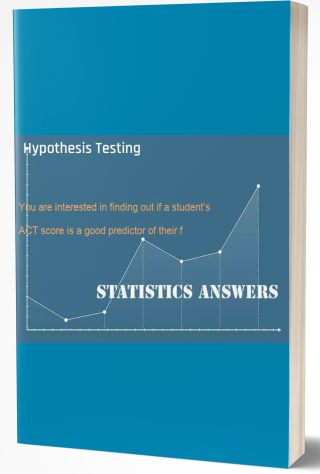Solution) It is believed that the average number of hours spent studying per day (HOURS) during undergraduate
Question: It is believed that the average number of hours spent studying per day (HOURS) during undergraduate education should have a positive linear relationship with starting salary (SALARY, measured in thousands of dollars per month) after graduation. Given below is the Excel output from regressing starting salary on number of hours spent studying per day for a sample of 51 students.
| Regression Statistics | ||||||||||
| Multiple R | 0.8857 | |||||||||
| R Square | 0.7845 | |||||||||
| Adjusted R Square | 0.7801 | |||||||||
| Standard Error | 1.3704 | |||||||||
| Observations | 51 | |||||||||
| ANOVA | ||||||||||
| Df | SS | MS | F | |||||||
| Regression | 1 | 335.0472 | 335.0473 | 178.3859 | ||||||
| Residual | 49 | 92.0326 | 1.8782 | |||||||
| Total | 50 | 427.0798 | ||||||||
| Coefficients | Standard Error | t Stat | p-value | Lower 95% | Upper 95% | |||||
| Intercept | -1.8940 | 0.4018 | -4.7134 | 2.051E-05 | -2.7015 | -1.0865 | ||||
| HOURS | 0.9795 | 0.0733 | 13.3561 | 5.944E-18 | 0.8321 | 1.1269 | ||||
(a) State the regression equation.
(b) Interpret the meaning of b0 and b1 in this problem.
(c) What is the predicted value of starting salary when the average number of hours spent studying per day is 5?
(d) At the 0.05 level of significance, is there evidence of a positive linear relationship between the average number of hours spent studying per day and the starting salary?
(e) Construct a 95% confidence interval estimate of the population slope β1. Interpret the confidence interval estimate.
(f) How useful do you think this regression model is for predicting the starting salaries?
Type of Deliverable: Word Document




![[Solution] Explain what is meant by the term “homoscedasticity.” #11512 Hypothesis Testing - Analysis of Variance (ANOVA)](/images/downloads-images/featured/Statistics-question-8629.jpg)
![[Solution] An executive at Hughes drives from his home to work every day. The driving times are normally distri #8740 Hypothesis Testing](/images/downloads-images/featured/Statistics-question-15578.jpg)

